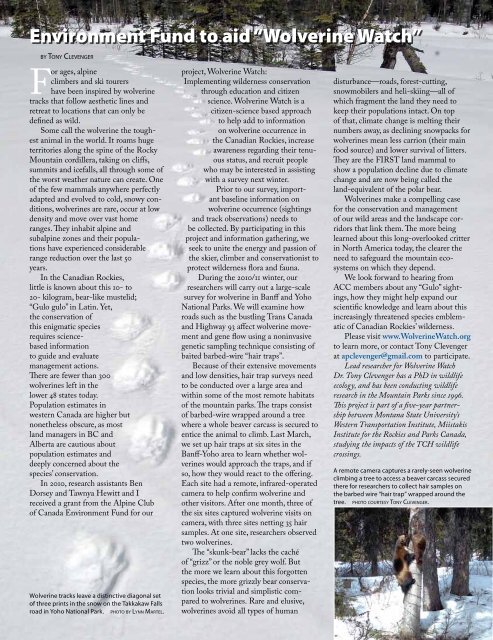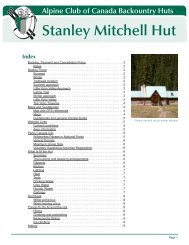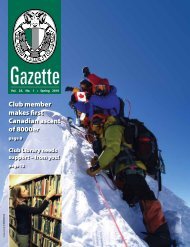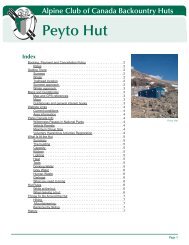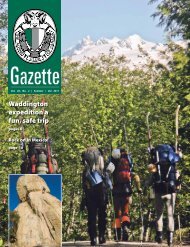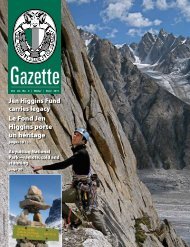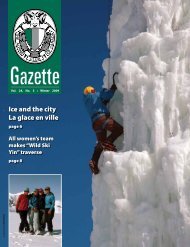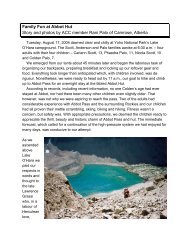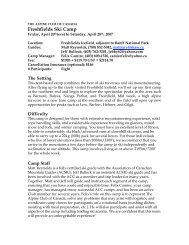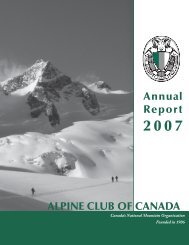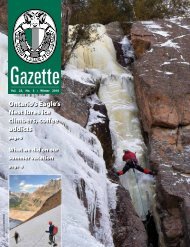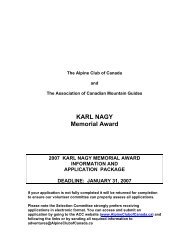Summer 2010 - The Alpine Club of Canada
Summer 2010 - The Alpine Club of Canada
Summer 2010 - The Alpine Club of Canada
Create successful ePaper yourself
Turn your PDF publications into a flip-book with our unique Google optimized e-Paper software.
Environment Fund to aid “Wolverine Watch”<br />
by Tony Clevenger<br />
For ages, alpine<br />
climbers and ski tourers<br />
have been inspired by wolverine<br />
tracks that follow aesthetic lines and<br />
retreat to locations that can only be<br />
defined as wild.<br />
Some call the wolverine the toughest<br />
animal in the world. It roams huge<br />
territories along the spine <strong>of</strong> the Rocky<br />
Mountain cordillera, taking on cliffs,<br />
summits and icefalls, all through some <strong>of</strong><br />
the worst weather nature can create. One<br />
<strong>of</strong> the few mammals anywhere perfectly<br />
adapted and evolved to cold, snowy conditions,<br />
wolverines are rare, occur at low<br />
density and move over vast home<br />
ranges. <strong>The</strong>y inhabit alpine and<br />
subalpine zones and their populations<br />
have experienced considerable<br />
range reduction over the last 50<br />
years.<br />
In the Canadian Rockies,<br />
little is known about this 10- to<br />
20- kilogram, bear-like mustelid;<br />
“Gulo gulo” in Latin. Yet,<br />
the conservation <strong>of</strong><br />
this enigmatic species<br />
requires sciencebased<br />
information<br />
to guide and evaluate<br />
management actions.<br />
<strong>The</strong>re are fewer than 300<br />
wolverines left in the<br />
lower 48 states today.<br />
Population estimates in<br />
western <strong>Canada</strong> are higher but<br />
nonetheless obscure, as most<br />
land managers in BC and<br />
Alberta are cautious about<br />
population estimates and<br />
deeply concerned about the<br />
species’ conservation.<br />
In <strong>2010</strong>, research assistants Ben<br />
Dorsey and Tawnya Hewitt and I<br />
received a grant from the <strong>Alpine</strong> <strong>Club</strong><br />
<strong>of</strong> <strong>Canada</strong> Environment Fund for our<br />
Wolverine tracks leave a distinctive diagonal set<br />
<strong>of</strong> three prints in the snow on the Takkakaw Falls<br />
road in Yoho National Park. photo by Lynn Martel.<br />
project, Wolverine Watch:<br />
Implementing wilderness conservation<br />
through education and citizen<br />
science. Wolverine Watch is a<br />
citizen-science based approach<br />
to help add to information<br />
on wolverine occurrence in<br />
the Canadian Rockies, increase<br />
awareness regarding their tenuous<br />
status, and recruit people<br />
who may be interested in assisting<br />
with a survey next winter.<br />
Prior to our survey, important<br />
baseline information on<br />
wolverine occurrence (sightings<br />
and track observations) needs to<br />
be collected. By participating in this<br />
project and information gathering, we<br />
seek to unite the energy and passion <strong>of</strong><br />
the skier, climber and conservationist to<br />
protect wilderness flora and fauna.<br />
During the <strong>2010</strong>/11 winter, our<br />
researchers will carry out a large-scale<br />
survey for wolverine in Banff and Yoho<br />
National Parks. We will examine how<br />
roads such as the bustling Trans <strong>Canada</strong><br />
and Highway 93 affect wolverine movement<br />
and gene flow using a noninvasive<br />
genetic sampling technique consisting <strong>of</strong><br />
baited barbed-wire “hair traps”.<br />
Because <strong>of</strong> their extensive movements<br />
and low densities, hair trap surveys need<br />
to be conducted over a large area and<br />
within some <strong>of</strong> the most remote habitats<br />
<strong>of</strong> the mountain parks. <strong>The</strong> traps consist<br />
<strong>of</strong> barbed-wire wrapped around a tree<br />
where a whole beaver carcass is secured to<br />
entice the animal to climb. Last March,<br />
we set up hair traps at six sites in the<br />
Banff-Yoho area to learn whether wolverines<br />
would approach the traps, and if<br />
so, how they would react to the <strong>of</strong>fering.<br />
Each site had a remote, infrared-operated<br />
camera to help confirm wolverine and<br />
other visitors. After one month, three <strong>of</strong><br />
the six sites captured wolverine visits on<br />
camera, with three sites netting 35 hair<br />
samples. At one site, researchers observed<br />
two wolverines.<br />
<strong>The</strong> “skunk-bear” lacks the caché<br />
<strong>of</strong> “grizz” or the noble grey wolf. But<br />
the more we learn about this forgotten<br />
species, the more grizzly bear conservation<br />
looks trivial and simplistic compared<br />
to wolverines. Rare and elusive,<br />
wolverines avoid all types <strong>of</strong> human<br />
disturbance—roads, forest-cutting,<br />
snowmobilers and heli-skiing—all <strong>of</strong><br />
which fragment the land they need to<br />
keep their populations intact. On top<br />
<strong>of</strong> that, climate change is melting their<br />
numbers away, as declining snowpacks for<br />
wolverines mean less carrion (their main<br />
food source) and lower survival <strong>of</strong> litters.<br />
<strong>The</strong>y are the FIRST land mammal to<br />
show a population decline due to climate<br />
change and are now being called the<br />
land-equivalent <strong>of</strong> the polar bear.<br />
Wolverines make a compelling case<br />
for the conservation and management<br />
<strong>of</strong> our wild areas and the landscape corridors<br />
that link them. <strong>The</strong> more being<br />
learned about this long-overlooked critter<br />
in North America today, the clearer the<br />
need to safeguard the mountain ecosystems<br />
on which they depend.<br />
We look forward to hearing from<br />
ACC members about any “Gulo” sightings,<br />
how they might help expand our<br />
scientific knowledge and learn about this<br />
increasingly threatened species emblematic<br />
<strong>of</strong> Canadian Rockies’ wilderness.<br />
Please visit www.WolverineWatch.org<br />
to learn more, or contact Tony Clevenger<br />
at apclevenger@gmail.com to participate.<br />
Lead researcher for Wolverine Watch<br />
Dr. Tony Clevenger has a PhD in wildlife<br />
ecology, and has been conducting wildlife<br />
research in the Mountain Parks since 1996.<br />
This project is part <strong>of</strong> a five-year partnership<br />
between Montana State University’s<br />
Western Transportation Institute, Miistakis<br />
Institute for the Rockies and Parks <strong>Canada</strong>,<br />
studying the impacts <strong>of</strong> the TCH wildlife<br />
crossings.<br />
A remote camera captures a rarely-seen wolverine<br />
climbing a tree to access a beaver carcass secured<br />
there for researchers to collect hair samples on<br />
the barbed wire “hair trap” wrapped around the<br />
tree. photo courtesy Tony Clevenger.


